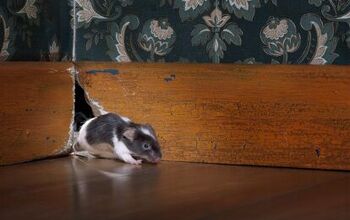How Do Mice Get In An Upstairs Apartments? (Find Out Now!)

The only thing worse than coming across a bug in your apartment is finding a mouse. When mice get into your apartment they bring with them harmful diseases and can, and will, chew through boxes to consume your food. Of course, the ideal outcome is to keep them out of your apartment in the first place, but one has already gotten in, you may be wondering: “How do mice get in upstairs apartments?”
Depending on the species, mice are excellent jumpers. They can also climb up two or three stories via the sheetrock, insulation, and wood beams in the walls of your apartment. So, even if you live in an upstairs apartment, you can still be susceptible to mouse infestations.
Continue reading for a deeper look at how mice get into apartments, how to identify a mouse problem, and what steps you can take to get rid of mice in your apartment.
Do You Need Pest Control Services?
Get free, zero-commitment quotes from pro contractors near you.

How to Identify a Mouse Problem in Your Apartment
The first step in ridding your home of a mouse is to identify its presence. If you suspect that your apartment has nocturnal visitors, here are some of the most common signs to look out for:
Droppings
Mouse droppings are one of the most obvious signs of a mouse problem in your apartment. Generally speaking, their feces are small, dark in color, and have a granular shape. They are roughly the size of a small paper clip and look like small pellets. Finding mouse droppings is a good indication that the mice has found a food source.
Use a flashlight to find droppings easier and look in all the possible places where the mice are hiding and nesting. Mouse droppings can have dangerous pathogens, so collecting and disposing of them safely is very important. Never touch droppings without wearing gloves and a mask. Also, do not sweep or vacuum them up. Pick up the droppings, place them in a sealed bag, and disinfect the area.
Noises
Mice make scratching sounds with their feet when they move around and squeaking noises with their mouths. Since mice are nocturnal, they are most active at night and this is when you’ll hear them most clearly. You will typically be able to hear them running across your floor and/or scurrying within your walls.
Foul Odor
Mouse urine has a very strong odor, making it one of the tell-tale signs that you have a mouse problem in your apartment. The odor is slightly musky and will be strongest in the areas where they congregate most, such as their nesting site. In most cases, animals will be the first to detect the scent of mouse urine.
If your cat or dog starts to show interest in areas where they didn’t care about previously, it may a sign that you have mice in your apartment. For larger mouse infestations, the strong, ammonia-like smell will be more apparent.
Gnaw Marks
Bite marks left from mice can be found on pretty much any item in your apartment. Though, you’ll see them more commonly on food or items used as a nesting material. Mice are chewers and holes in clothing, packing materials, boxes, and food bags indicate that they’ve found a food source.
Steps for Getting Rid of Mice in Your Apartment
After you’ve identified that you have a mouse, or mice, in your apartment, follow the steps below to get rid of them quickly.
1. Contact Your Landlord
Your landlord doesn’t want mice in your apartment just as much, if not more, as you don’t. They’ll typically want to address the issue fast, as they don’t want mice on their property. If you’re lucky, your landlord will call in a pest control specialist to help. Even if a professional exterminator does come out to your apartment, there are other measures that can be taken to eliminate your mouse problem and prevent future infestations.
2. Find The Entry Points
Although getting a mouse out of your apartment is great, they’ll keep coming back if you don’t figure out how they got in in the first place. Inspect all the common ways that mice can gain entry into homes, including cracks in door frames and window sills, piping in your bathrooms and kitchens, or even a doggy door.
Even if you live on the higher floor of an apartment building, you’re not immune to these intruders. Mice can make their way in via gaps in siding, plumbing, and the AC/ heating system. In fact, mice can squeeze themselves into the tiniest of spaces, as small as ¼ of an inch. This is roughly the size of a pencil eraser. Only their skull has to fit through the hole, and the rest of their body can easily fit through.
Once you figure out how the mouse got in, call maintenance so they can make the needed repairs or take matter into your own hands by:
- Patching holes
- Filling in any cracks
- Repairing piping and drains
- Installing screens on doors and windows
3. Keep Your Apartment Clean
One of the best ways to keep mice out of an apartment is to simply keep it clean. This includes picking up your clothes, wiping down your counters often, putting your shoes away, making sure the garbage doesn’t get too full, and not leaving dirty dishes in your sink. You should also vacuum, mop, and sweep regularly and try to keep as many items off of your floor as possible to reduce their hiding spots.
4. Store Food Properly
As previously mentioned, mice can squeeze into very tiny spaces. This means that they can, and will, make their way into your cabinets. All non-refrigerated food, like coffee grounds, crackers, chips, and rice, should be placed in air-tight plastic or glass containers, or inside your fridge or freezer. Mice can chew through bags and boxes, so leaving anything out provides a food source for them. This also means not leaving out fruit bowls or open bags of chips.
5. Start Trapping and Baiting
Your landlord or property manager will mostly likely take care of this, but if not, there are steps you can take to get rid of mice. Position traps and baits in areas of your apartment where mice like to hide, including inside cabinets, underneath furniture, and pretty much anywhere else that is dark and sheltered. Since the kitchen is the biggest food supply for mice, it should be the most covered in baits and traps. For best results, place more traps and baits inside your pantry, under the fridge, and near your stove.
What is trapping?Trapping involves luring a mouse using a treat positioned on a designated trap. When the mechanism is activated, the trap prevents the mouse from escaping. There are numerous types of traps to choose from depending on your preferences, including snap traps, glue traps, and humane cage traps. The trap you choose will likely depend on how comfortable you are with handling the mouse after it is caught.
A snap trap is probably one of the most well-known traps. It is used with bait (cheese or peanut butter) and snaps closed, killing the mouse, when the bait is removed. Glue traps have a sticky substance that prevents the mouse from getting away. Though, if either are too inhumane for you, cage (or box) traps have a one-way door that shuts, trapping the mouse inside, when activated. This option does not harm them and allows you to release the mouse a great distance from your apartment.
What is baiting?Mice baiting refers to luring the rodents using food that is desirable to them, but does not involve trapping. Renters commonly use bait stations that have mouse poison and a clear entrance big enough for a mouse but not big enough for children or pets. When the bait is ingested, the mouse will take the poison back to the nest and die.
While baiting can be an effective option for getting rid of mice, you still have to dispose of the remains. Whether you’re squeamish or simply want to eliminate your mouse problem in a more humane way, you may want to opt for a different method.
6. Check Traps and Bait Often
When you have a mouse problem, it’s highly advised that you check your baits and traps a couple times a day. Since mice can carry diseases, you want to get it out of your apartment as soon as they are caught. Oftentimes, if the mouse is caught but still alive it will urinate from fear, which can quickly spread diseases.
Do You Need Pest Control Services?
Get free, zero-commitment quotes from pro contractors near you.

How Do Mice Get in Upstairs Apartments?
Even if you live in an upstairs apartment, you are not immune to a mouse infestation. Mice can enter upper-level apartments via the wood beams, insulation, or sheetrock in the walls. They can even climb the outside walls and enter through poorly-sealed doors and windows, gaps in your siding, your heating/ AC system, and the plumbing.
The first step is to identify you have a mouse problem, the contact your landlord, find out how they’re getting in, and take all the necessary preventative measures.
Related Guide

Jessica considers herself a home improvement and design enthusiast. She grew up surrounded by constant home improvement projects and owes most of what she knows to helping her dad renovate her childhood home. Being a Los Angeles resident, Jessica spends a lot of her time looking for her next DIY project and sharing her love for home design.
More by Jessica Stone



























